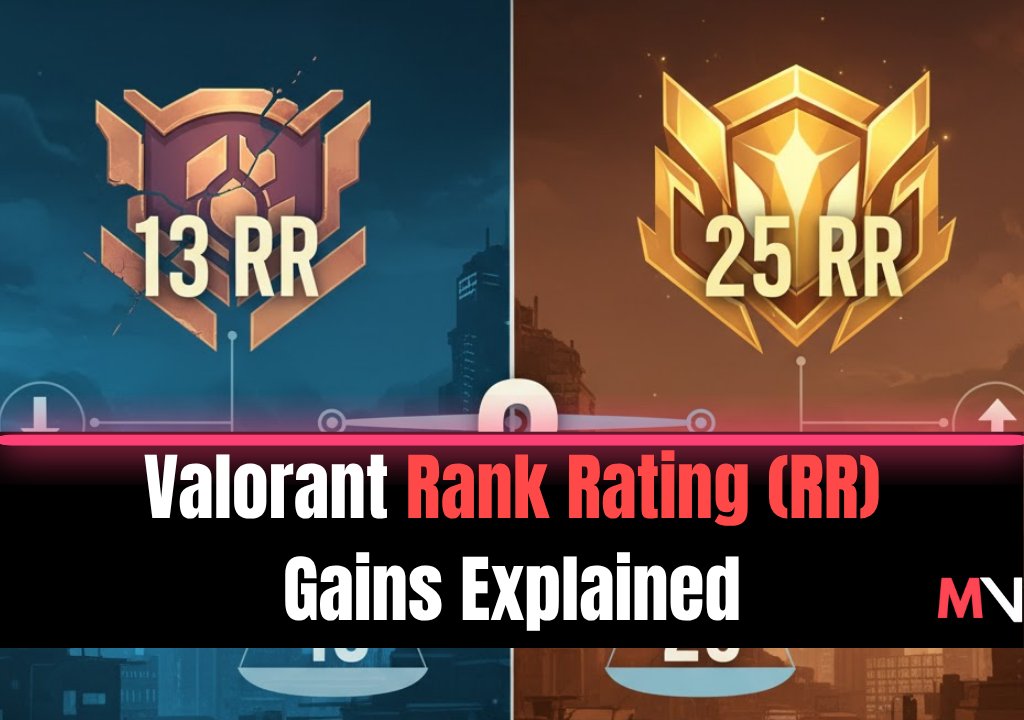Valorant Rank Rating (RR) Gains Explained
Have you ever won a Valorant ranked game and felt good about it, only to see a disappointing +13 RR gain instead of the usual +20–25? You're not the only one. This difference confuses players worldwide, but the explanation lies deep within Riot’s hidden MMR system, which controls how much Rank Rating you gain or lose each match.
🎯 What Rank Rating (RR) Means in Valorant
The visible number that shows how far you've come in your current tier is called Rank Rating (RR). You need 100 RR to move up in rank, and if you lose and your RR drops to 0, you will be demoted.
But RR isn't just a number; it depends on your hidden MMR (Matchmaking Rating). Your MMR is what truly determines your skill level, while RR is just the visible layer of progress that tries to match it.
⚙️ The Core Relationship: MMR and RR
Your RR gains are tied to whether your hidden MMR is above or below your visible rank.
- You get more RR and lose less RR per game if your MMR is higher than your rank.
- If your MMR is lower than your rank, you get less RR and lose more RR until your rank matches your skill level.
This is why one player might get +25 RR for each win and another player in the same rank might only get +13 RR. It all depends on how well their hidden and visible ratings match up.
🧩 Why You Get +13 RR Instead of +25
1. Your Hidden MMR Is Below Your Rank
This is the most common reason. The system thinks that your visible rank doesn't match your current skill level, so it's trying to bring them both into line. Until you show that you can do well consistently, you'll get fewer points for each win.
2. Your Wins Are Too Close Together
Valorant's system looks at how you win. A 13–11 victory doesn’t impress the algorithm as much as a 13–4 win. The RR gain gets smaller as the match gets closer.
3. You Did Okay
Individual performance still matters in the lower tiers (Iron through Diamond). If your KDA, utility use, and round impact are lower than average, even if you win, you'll get less RR.
4. Balance in Matchmaking
When your team is favored to win (based on MMR difference), the RR reward is smaller. On the other hand, beating opponents with a higher rating gives you a bigger RR gain.
5. Losing Streaks Lately
Your hidden MMR probably went down if you've been losing more than winning lately. The system takes time to "trust" that your performance has improved, so RR growth will be slower even if you start winning again.
🧠 How to Make Your RR Gains Bigger
1. Try to Win by a Lot
Try to win rounds decisively and don't let games go into extra time. The system likes wins that are clear and strong.
2. Play Consistently
Don't play in streaks. Keeping your KDA, first-blood ratios, and objective contribution steady across games will raise your MMR faster than random bursts of good play.
3. Focus on Impact Rounds
Winning important clutch rounds or helping with multi-kill entries will raise your rating. The algorithm looks at how much your presence changes the outcome of the round.
4. Stand in Line During Balanced Hours
Play at peak times, like in the evening, when there are more people to match with. You'll get matches that are more even and better show how well you really play.
5. Keep the Winning Streaks Going
Riot's MMR system rewards players who keep going. If you win three or four times in a row, you'll see bigger RR gains after that.
🔓 Final Thoughts
Getting only +13 RR instead of +25 doesn't mean the system is broken; it just means that it's adjusting your hidden MMR to match how well you've been doing lately. That algorithm gets data from every game, and your RR gains will go back up once you get better at being consistent.
Stay calm, stay focused, and remember that every win is part of a bigger trend, not just a single number.
💡 Keep an Eye on Your MMR and RR Progress in Real Time
Do you want to know if your hidden MMR is behind or finally catching up to your visible rank? Go to https://mmrvalorant.com/
to see your MMR trajectory, how often you win, and how your rank is going up in real time. Stop making guesses about your RR logic and start keeping track of it with data-driven accuracy.
Tags

Author




